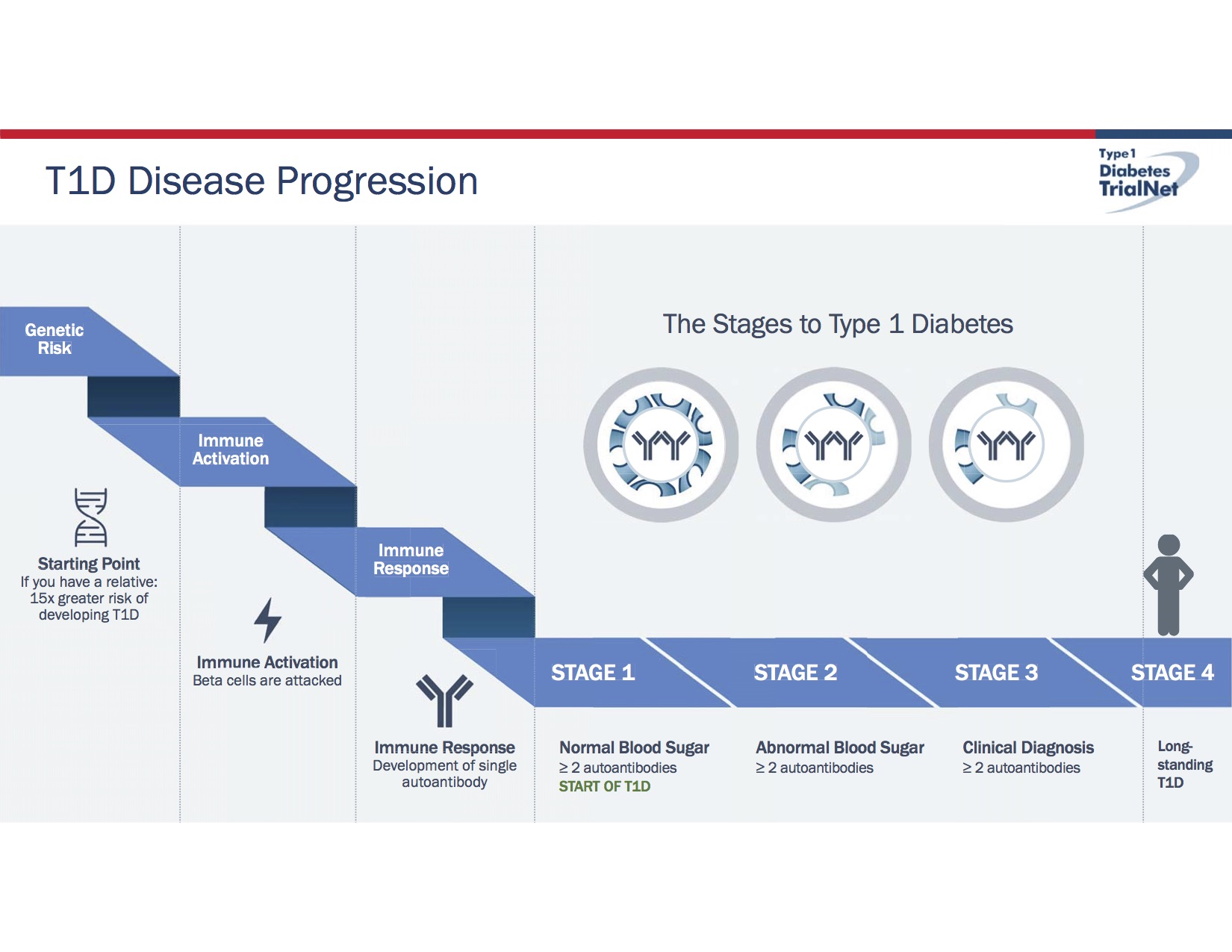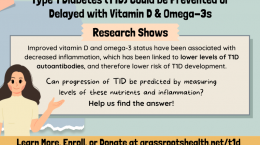Published on November 13, 2023
November 14th is World Diabetes Day – Learn what factors contribute to your risk of Type 1, Type 2, and Type 1.5 Diabetes, and how to help prevent diagnosis
 Tomorrow, November 14, is World Diabetes Day. This year’s slogan is “Know Your Risk, Know Your Response.” According to worlddiabetesday.org
Tomorrow, November 14, is World Diabetes Day. This year’s slogan is “Know Your Risk, Know Your Response.” According to worlddiabetesday.org
“1 in 10 adults worldwide have diabetes. Over 90% have type 2 diabetes. Close to half are not yet diagnosed. In many cases, type 2 diabetes and its complications can be delayed or prevented by adopting and maintaining healthy habits. Knowing your risk and what to do is important to support prevention, early diagnosis and timely treatment.”
Below we describe Type 1, Type 2, and Type 1.5 diabetes, risk factors for each, ways to measure risk and steps that can be taken to help prevent diagnosis.
Type 1 Diabetes
Type 1 diabetes (T1D) has historically been thought of as a childhood-onset disease, hence referred to as ‘juvenile onset’ diabetes. However, a 2022 review by Harding et al. demonstrated that the incidence of adult-onset T1D (among those 20 years or older) is substantial and is often misdiagnosed as type 2 diabetes. These cases could instead be cases of Type 1.5 Diabetes (or Latent Autoimmune Diabetes), as described below.
Both Type 1 and Type 1.5 Diabetes are autoimmune disorders involving the presence of islet cell autoantibodies, and their presence can be used as markers of the process that can cause autoimmune type diabetes.

The presence of autoantibodies can change over time, and CAN BE REVERSED as they can be influenced by factors such as the status of the body’s immune system and levels of inflammation. Improved vitamin D and omega-3 status, as well as decreased inflammation, have been associated with lower levels of these autoantibodies and therefore lower risk of T1D progression and development.
Are You at Risk for Type 1 Diabetes?
Whether discussing the research on type 1 diabetes or type 2 diabetes (see below), evidence has shown that maintaining a vitamin D blood level of 40-60 ng/ml (100-150 nmol/L) and an AA:EPA ratio below 3 may help delay or prevent the development of either, likely due to the roles of vitamin D and omega-3s in managing inflammation and regulating the immune system.
A protocol involving vitamin D and omega-3s is now being implemented to help decrease the progression of T1D among those at risk. If you or someone you know has tested positive for T1D autoantibodies in the past, and have not yet been diagnosed with T1D, follow-up testing for both autoantibodies and vitamin D and omega-3 status is highly recommended. We encourage these individuals to enroll in our Type 1 Diabetes Prevention Project today.
Type 2 Diabetes
Insulin resistance is when cells in your body don’t respond well or are resistant to insulin which leads to increased blood sugar and eventually type 2 diabetes (T2D). The prevalence of T2D has been increasing over the past decade and more than 34 million Americans are living with this disease. Worse, T2D, formerly called “adult-onset diabetes” because it often develops in people over the age of 45 years, is being diagnosed more and more in young children and teenagers with life-long consequences. Insulin resistance is often accompanied by other symptoms of metabolic syndrome, including high blood pressure, high blood sugar, high triglyceride levels, low HDL cholesterol levels, and excess body fat around the waist.

Measuring the percentage of hemoglobin A1c in the blood provides information about the average blood glucose levels over the prior few months. Generally, levels below 5.7% are considered normal, 5.7% to 6.4% are considered prediabetic, and levels of 6.5% or higher are considered diabetic. This test can be used to help diagnose type 2 diabetes and prediabetes and for diabetes management.
Pre-diabetes is a condition involving insulin resistance, in which blood sugar levels are higher than normal, but not high enough to be considered type 2 diabetes. It is estimated that 1 in 3 Americans have prediabetes and approximately 80% don’t even know it. It often takes several years for type 2 diabetes symptoms to develop, and because the symptoms are hard to spot, it can go on for a long time without being noticed. This means that you can have prediabetes or even type 2 diabetes and not know it. The good news is you can prevent it… in fact
- vitamin D is linked to improved insulin resistance, insulin secretion, and beta-cell function and survival; the risk of developing insulin resistance and/or diabetes over time increases with lower vitamin D levels
- one recent meta-analysis found a 76% reduced risk of diabetes among individuals with prediabetes who maintained a vitamin D blood level of at least 50 ng/ml (125 nmol/L) compared to those with a vitamin D level of 20-29 ng/ml (50 to 74 nmol/L)
- there is a significant, inverse association between magnesium status and the future diagnosis of type 2 diabetes, with a lower magnesium status among those who started without diabetes but were diagnosed before the end of the 5 year follow up compared to those who remained diabetes free
- while higher vitamin D levels are associated with a decreased incidence of type 2 diabetes, the significance of the effect seems to be greater among those who get more magnesium
- magnesium deficiency has been linked to both higher body fat and an increased risk of metabolic syndrome
- supplementing with both vitamin D and omega-3s has resulted in significant reductions in fasting blood glucose, insulin, beta cell function (HOMA-B), and total cholesterol with a significant increase in HDL-C levels
Are You at Risk for Type 2 Diabetes?
If you have one or more risk factors or experience any symptoms of diabetes, you may be at risk for type 2 diabetes. Symptoms include being very thirsty, urinating often, blurry vision, feeling tired, numbness or tingling in the hands or feet, and having more infections than usual. However, symptoms often develop slowly without being noticed and sometimes there are no observable symptoms at all. Measuring the HbA1c level in the blood provides information about the average blood glucose levels over the prior few months. Knowing your HbA1c, vitamin D, and inflammation levels can enable you to focus your health efforts on lifestyle changes, such as diet, exercise, improving omega-3 status and magnesium intake, decreasing inflammation, and increasing vitamin D levels to 40-60 ng/ml (100-150 nmol/L), all of which can help prevent, or even reverse, prediabetes.
Measure all of the above with the Inflammation Panel plus Magnesium test kit.
Type 1.5 Diabetes, also known as Latent Autoimmune Diabetes
A subtype of Type 1 Diabetes called Type 1.5 Diabetes (or Latent Autoimmune Diabetes in Adults/LADA) is characterized by the same autoimmune destruction of the cells of the pancreas as seen in T1D, but since it occurs in adulthood, it is often misdiagnosed as Type 2 Diabetes. An estimated 50% of those diagnosed with non-obesity related type 2 diabetes actually have type 1.5 diabetes. Overall, an estimated 5-10% of adults diagnosed with type 2 diabetes may have type 1.5. Indication of an incorrect type 2 diabetes diagnosis could include lower weight than the usual type 2 person or the presence of another autoimmune disease, a family history of T1D or other autoimmune diseases, or earlier need for insulin than most with Type 2 (within a couple of years of diagnosis).
It is important to get the correct diagnosis in order to get the correct treatment protocol to manage blood glucose and symptoms; measuring the Type 1 Tiabetes autoantibodies is the way to correctly diagnose, as testing positive for one or more indicates Type 1 or 1.5 Diabetes.
Add the T1D Autoantibody Blood Spot Test to your Custom Kit here
Order the Type 1 Diabetes Prevention Test Kit here
How can you share about this for World Diabetes Day?
- Forward this newsletter/blog
- Share our post on social media
- Share any of our diabetes related blogs and charts on social media quickly and easily by using the social media share buttons at the top of each of our blogs
Find us on
Have Fun Sharing this World Diabetes Day!
Measure Your Levels of the Above with Your Custom Home Test Kit
 Create your custom home test kit to measure your levels at home as part of the D*action project!
Create your custom home test kit to measure your levels at home as part of the D*action project!
With your kit you can measure your:
- Vitamin D
- Magnesium PLUS Essential and Toxic Elements
- Omega-3 Fatty Acids
- hsCRP
- HbA1c
- TSH
- Type 1 Diabetes Autoantibodies
Did you know that each of the above can be measured at home using a simple blood spot test? As part of our ongoing research project, you can order your home blood spot test kit to get your levels, followed by education and steps to take to help you reach your optimal target levels. Start by enrolling and ordering your kit to measure each of the above important markers, and make sure you are getting enough of each to support better mood and wellbeing!
Create your custom home test kit today. Take steps to improve the status of each of these measurements to benefit your overall health. With measurement you can then determine how much is needed and steps to achieve your goals. You can also track your own intakes, symptoms and results to see what works best for YOU.






